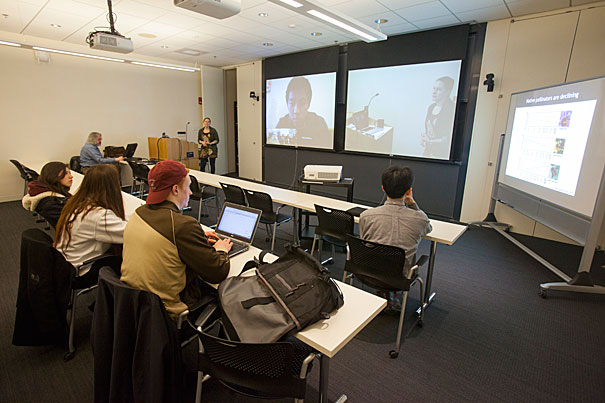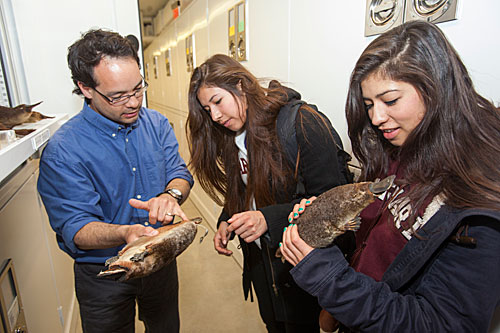
Guest lecturer Sarah Kocher used the built-in cameras and three large screens in the Northwest Lab classroom for a videoconference. Other institutions’ students joined the Harvard class remotely, creating a single virtual classroom. The class is part of a five-year initiative whose goal is to increase the use of museum collections in teaching.
Photos by Jon Chase/Harvard Staff Photographer
Melding the Web and the tactile
Harvard, other schools create a virtual classroom that uses museum collections
Alessa Moscoso and Mike Seward peered at the mountain lion just a few feet away. The animal didn’t peer back, or do anything else.
That’s because the two Harvard undergraduates were looking at a specimen in the mammalogy collection of Harvard’s Museum of Comparative Zoology (MCZ). The mountain lion shares a cabinet in the basement of the Northwest Laboratory Building with jaguars and wolves, and a room with thousands of other specimens, carefully cataloged and arranged in the large, cream-colored cabinets that take up most of the floor space.
The students were touring the collection as part of an unusual, multi-institutional class that seeks to better integrate the vast museum collections at Harvard and a handful of other universities into classroom teaching. After the tour, Moscoso and Seward returned to the Northwest Lab classroom where technicians had been setting up the videoconferencing equipment needed for the day’s lesson.
Using built-in cameras and three large screens at the front of the room, guest lecturer Sarah Kocher, a postdoctoral fellow working with Naomi Pierce, Hessel Professor of Biology, and Hopi Hoekstra, professor of organismic and evolutionary biology, taught a class to students at Harvard, Occidental College, and the University of New Mexico.
The other institutions’ students joined the Northwest Lab class remotely, their own classrooms displayed on a large screen at the front, creating a single virtual classroom. A second screen showed Kocher as she spoke, while a third displayed her presentation on the use of museum collections in research into the genomics of social behavior in bees.
“Our main goal is to get people to increase the use of museum collections and to realize that there’s a treasure trove of research and teaching information in these collections,” said Alexander Agassiz Professor of Zoology in the Department of Organismic and Evolutionary Biology Scott Edwards, who leads the class. “Many museum collections go back over a century. These collections offer an amazing resource to convey to students basic concepts in biology and evolution.”
The class is part of a five-year initiative whose goal is to increase the use of museum collections in teaching. The initiative, called AIM-UP, or Advancing Integration of Museums into Undergraduate Programs, is funded by the National Science Foundation and is headed by a steering committee that includes Edwards, Joseph Cook at the University of New Mexico’s Museum of Southwestern Biology, Stefanie Ickert-Bond of the University of Alaska’s Museum of the North, and Eileen Lacey of the University of California’s Museum of Vertebrate Zoology.
Each year, a different institution takes the lead in presenting a class that highlights the importance of museum collections in a different way. Last year, the University of New Mexico offered a class on the interdisciplinary use of collections in biology and art. This year’s class, OEB 275br, is on evolutionary genomics and museum collections.
Seward, a sophomore in Dunster House, said he took the class after receiving an email notice sent to organismic and evolutionary biology (OEB) concentrators.
“As a kid growing up, I used to love museums,” Seward said. “I used to love the animal exhibits at the Museum of Science.”
With just a handful of students, the small size of the class is a draw for Moscoso, an Adams House junior, who said many of her prior biology classes were taught in large lecture formats.
“It’s really one-on-one; it’s been great,” Moscoso said.

More and more, museums are digitizing collections, creating Internet-based databases of their specimens, posting information on the Web about where specimens were collected, and when and by whom, along with photographs, and in some cases three-dimensional scans.
The AIM-UP initiative has been strengthened by this growing digitization, Edwards said, which not only has highlighted the vast amounts of information that collections hold but also has made the data much more accessible. Scholars can use the arrayed specimens to understand the range of characteristics of a species, and modern genomics can explore the creatures’ DNA and give a deeper understanding of their relationships to other species. Often collected over decades, the specimens can provide a look back in time at how a species has changed, or, by looking for trace pollutants, how the environment has changed.
One challenge facing AIM-UP is to make the use of these collections in education more acceptable. For generations, curators’ main mission has been to ensure that collections are available into the future, something that may be endangered by the wear and tear of classroom use. While the MCZ doesn’t have a teaching collection, Edwards said some institutions have solved the problem by setting aside some specimens for classroom use.
In the middle of April, the MCZ hosted AIM-UP’s annual workshop, with more than a dozen representatives of participating institutions coming to Cambridge to talk about challenges, learn what fellow institutions are doing, and discuss new educational modules and other initiatives that incorporate museum collections.
Students in the class are developing educational projects that teach scientific concepts using the collections. Seward is working on a project that compares creatures’ family trees made using genetic relationships with those reconstructed using physical characteristics. Moscoso is examining the evolution of specific disease genes in Neanderthals, humans, and other primates.
“I think the project shows that there’s a lot of data out there all over the place,” Moscoso said.





